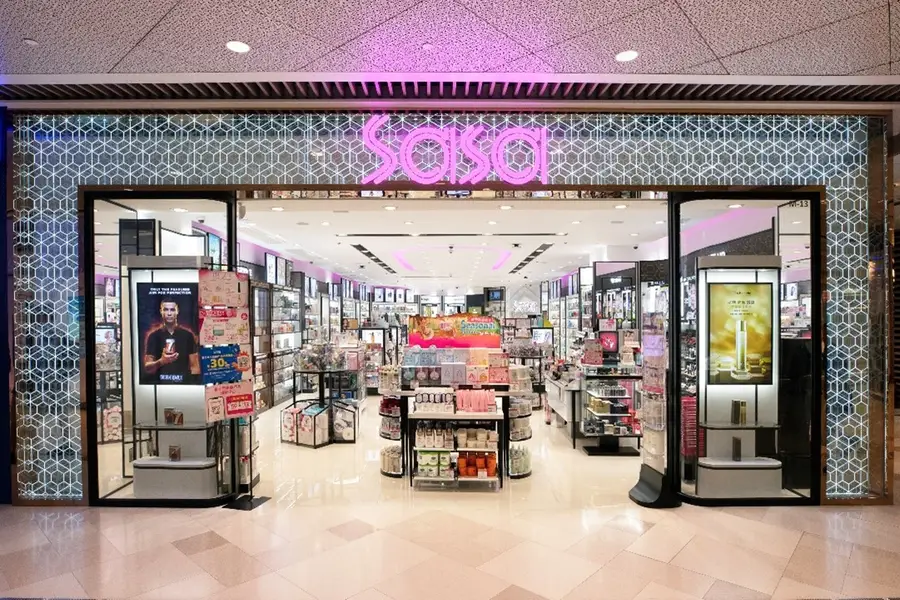Sa Sa tries on new e-commerce face in China as its Hong Kong core shrinks

The cosmetics retailer said revenue from its core Hong Kong and Macao markets fell by 11% to 12% in its fiscal year through March, causing profits to plunge by up to 68%
Key Takeaways:
- Sa Sa’s business in its core Hong Kong market contracted last year, as many local residents headed across the border to shop in Shenzhen
- The cosmetics seller’s Mainland China revenue fell by 40.5% in its fiscal fourth quarter through March, as it closed stores and shifted its focus to e-commerce
By Edith Terry
Cosmetics seller Sa Sa International Holdings Ltd. (0178.HK) is a Hong Kong success story, founded by the husband-wife team of Simon Kwok Siu-ming and Eleanor Kwok Law Kwa-chun in a tiny shopping mall basement in 1978. But after peaking at HK$8.9 billion ($1.15 billion) in revenue in 2015, their business has shrunk by more than half to just HK$4.36 billion for their fiscal year through March 2024.
The bad news kept coming in the company’s latest fiscal year, highlighted in an announcement last Friday warning its revenue fell about 10% year-on-year for the 12 months through March, while its profit plunged 63% to 68%. The company, whose pink storefronts with a mix of affordable cosmetics are ubiquitous in Hong Kong, has been undermined by some major demographic and consumer shifts that only seem to be accelerating.
Chief among those is a growing fondness by Hong Kongers for shopping across the border in Shenzhen, pressuring the company’s core Hong Kong and Macao business that accounts for about three-quarters of its revenue. Meantime, Mainland Chinese visiting Hong Kong, who were once a major customer base, are shopping less during their Hong Kong holidays as they look for less materialistic ways to spend their vacations.
The profit warning blamed those two factors for the company’s profit plunge to between HK$70 million to HK$80 million for its fiscal year through March, from HK$219 million the previous year.
Booming business in the year-ago period is also partly to blame for the recent declines, as revenge travel and shopping after the pandemic drove revenue up by 24.8% the previous year, as Sa Sa’s profit nearly quadrupled. But reality is quickly catching up with the company as the initial euphoria quickly faded and was replaced by consumer caution with China’s slowing economy.
Investors seemed ready for the bad news, especially since Sa Sa previously disclosed much of the revenue weakness in previous quarterly reports. The stock opened unchanged on Monday morning trading, though it’s down about 17% so far this year, missing a rally that has lifted many other Chinese stocks over the last half year.
The company’s price to earnings (P/E) ratio of 11.8 also looks quite depressed compared with the 30 for Chicmax (2145.HK) and an even higher 46 for Mao Geping Cosmetics (1318.HK), which targets the higher end of the market.
The profit warning and the latest quarterly results, both released last Friday, weren’t all bad news. While Sa Sa’s core market in Hong Kong and Macao is eroding, its Southeast Asia revenue, which accounts for about 10% of its total and comes mostly from Malaysia and Singapore, rose 17.3% in the three months to March, while online sales in that region jumped 36.5%. But Mainland China, which also accounts for about 10% of revenue, ominously plunged 40.5% in the three months to March.
Money loser
Sa Sa’s Mainland Chinese business has lost money in most years, and the good news is that it’s finally doing something to try to fix the problem by investing more in online resources and shutting down underperforming stores. The company was a latecomer to e-commerce in the Mainland, opening flagship stores on big e-commerce platforms only starting in 2015, even as it stuck to traditional retailing longer than most of its rivals.
The company’s main Hong Kong competitor, Watson’s, moved much more quickly, rolling out its own shopping app and opening a flagship store on Alibaba’s popular Taobao marketplace back in 2011. It has rolled out presences on other popular sites JD.com and Amazon since then.
To Sa Sa’s credit, it is finally changing course in China, culling its brick-and- mortar network and adopting a more asset-light operating model. Online business now accounts for 80% of the company’s Mainland China sales, and it plans to continue focusing on e-commerce by closing 18 physical stores and working with more third-party partners to sell its merchandise.
“The group believes that the adoption of an asset-light operating model will reduce operating costs and enhance economic efficiency,” Sa Sa said. It added it took a one-time provision of between HK$20 million and HK$30 million for store closures in its fiscal year through March.
While Sa Sa sees online shopping as its future on the Mainland, such online shopping is likely to remain low in its Hong Kong base. In the six months through September, online sales in its core Hong Kong and Macao markets accounted for just HK$94.8 million, or 7% of its HK$1.4 billion sales for those two markets. Overall revenue in Hong Kong and Macao was already slumping at that time, down by 18.4% year-on-year for the six-month period, though Mainland China was up by 27% during that time and Southeast Asia rose by 15%. But the dominance of Hong Kong in Sa Sa’s revenue mix caused total revenue for the six-month period to drop 10.4%.
The company’s core Hong Kong business is likely to keep coming under pressure as local consumers keep trekking to Shenzhen for fun and shopping. During this year’s Easter holiday between April 18 and April 21, some 1.6 million Hong Kongers headed to Mainland China, up 6.8% year-on-year. Many went to Shenzhen, where the relatively strong Hong Kong dollar gives them more buying power. That same factor also tends to dampen demand from Mainland shoppers who traditionally came to Hong Kong in search of bargains.
Sa Sa’s adaptation to the changing retail market looks like a much-needed adjustment, even if it’s coming late and creating some pain for the company. As its founders enter their 70s, succession issues also loom for the company. The most likely successor is their daughter, Melody Kwok Sze Wai, who joined as a management trainee in 2005 and was appointed vice president for corporate strategy and development in 2018.
Melody has kept a low profile compared to her flamboyant parents. But her relative youth, and more likely embrace of e-commerce, could surprise on the upside if she tries to bring the company more into line with the latest retailing trends.
To subscribe to Bamboo Works weekly free newsletter, click here





